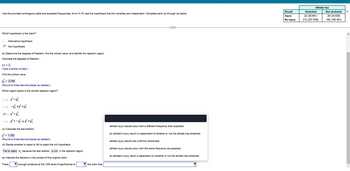
Glencoe Algebra 1, Student Edition, 9780079039897, 0079039898, 2018
18th Edition
ISBN: 9780079039897
Author: Carter
Publisher: McGraw Hill
expand_more
expand_more
format_list_bulleted
Question
thumb_up100%

Transcribed Image Text:Use the provided contingency table and expected frequencies. At a = 0.10, test the hypothesis that the variables are independent. Complete parts (a) through (e) below.
Which hypothesis is the claim?
Alternative hypothesis
Null hypothesis
(b) Determine the degrees of freedom, find the critical value, and identify the rejection region.
Calculate the degrees of freedom.
d.f.= 1
(Type a whole number.)
Find the critical value.
X₁ = 2.706
(Round to three decimal places as needed.)
Which region below is the correct rejection region?
OA. x²x²
OB. -xx²x²
c. x²x²²
OD. x-xor²x²
(c) Calculate the test statistic.
x= 1.762
(Round to three decimal places as needed.)
(d) Decide whether to reject or fail to reject the null hypothesis.
Fail to reject H, because the test statistic is not in the rejection region.
(e) Interpret the decision in the context of the original claim.
There
enough evidence at the 10% level of significance to
the claim that
athlete injury results occur with a different frequency than expected.
an athlete's injury result is independent of whether or not the athlete has stretched.
athlete injury results are uniformly distributed.
athlete injury results occur with the same frequency as expected.
an athlete's injury result is dependent on whether or not the athlete has stretched.
Athlete has
Not stretched
29 (24.539)
188 (192.461)
Result
Injury
No injury
Stretched
22 (26.481)
212 (207.539)
Expert Solution
This question has been solved!
Explore an expertly crafted, step-by-step solution for a thorough understanding of key concepts.
Step by stepSolved in 2 steps with 2 images

Knowledge Booster
Similar questions
Recommended textbooks for you
 Glencoe Algebra 1, Student Edition, 9780079039897...AlgebraISBN:9780079039897Author:CarterPublisher:McGraw Hill
Glencoe Algebra 1, Student Edition, 9780079039897...AlgebraISBN:9780079039897Author:CarterPublisher:McGraw Hill Linear Algebra: A Modern IntroductionAlgebraISBN:9781285463247Author:David PoolePublisher:Cengage Learning
Linear Algebra: A Modern IntroductionAlgebraISBN:9781285463247Author:David PoolePublisher:Cengage Learning Holt Mcdougal Larson Pre-algebra: Student Edition...AlgebraISBN:9780547587776Author:HOLT MCDOUGALPublisher:HOLT MCDOUGAL
Holt Mcdougal Larson Pre-algebra: Student Edition...AlgebraISBN:9780547587776Author:HOLT MCDOUGALPublisher:HOLT MCDOUGAL Big Ideas Math A Bridge To Success Algebra 1: Stu...AlgebraISBN:9781680331141Author:HOUGHTON MIFFLIN HARCOURTPublisher:Houghton Mifflin Harcourt
Big Ideas Math A Bridge To Success Algebra 1: Stu...AlgebraISBN:9781680331141Author:HOUGHTON MIFFLIN HARCOURTPublisher:Houghton Mifflin Harcourt Functions and Change: A Modeling Approach to Coll...AlgebraISBN:9781337111348Author:Bruce Crauder, Benny Evans, Alan NoellPublisher:Cengage Learning
Functions and Change: A Modeling Approach to Coll...AlgebraISBN:9781337111348Author:Bruce Crauder, Benny Evans, Alan NoellPublisher:Cengage Learning

Glencoe Algebra 1, Student Edition, 9780079039897...
Algebra
ISBN:9780079039897
Author:Carter
Publisher:McGraw Hill

Linear Algebra: A Modern Introduction
Algebra
ISBN:9781285463247
Author:David Poole
Publisher:Cengage Learning

Holt Mcdougal Larson Pre-algebra: Student Edition...
Algebra
ISBN:9780547587776
Author:HOLT MCDOUGAL
Publisher:HOLT MCDOUGAL

Big Ideas Math A Bridge To Success Algebra 1: Stu...
Algebra
ISBN:9781680331141
Author:HOUGHTON MIFFLIN HARCOURT
Publisher:Houghton Mifflin Harcourt

Functions and Change: A Modeling Approach to Coll...
Algebra
ISBN:9781337111348
Author:Bruce Crauder, Benny Evans, Alan Noell
Publisher:Cengage Learning